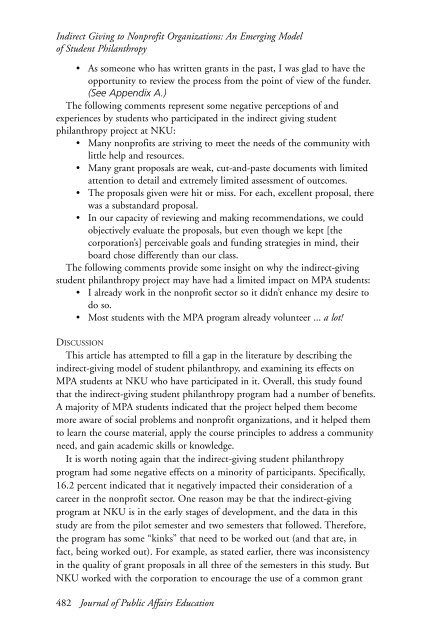JOURNAL OF PUBLIC AFFAIRS EDUCATION - National ...
JOURNAL OF PUBLIC AFFAIRS EDUCATION - National ...
JOURNAL OF PUBLIC AFFAIRS EDUCATION - National ...
You also want an ePaper? Increase the reach of your titles
YUMPU automatically turns print PDFs into web optimized ePapers that Google loves.
Indirect Giving to Nonprofit Organizations: An Emerging Model<br />
of Student Philanthropy<br />
• As someone who has written grants in the past, I was glad to have the<br />
opportunity to review the process from the point of view of the funder.<br />
(See Appendix A.)<br />
The following comments represent some negative perceptions of and<br />
experiences by students who participated in the indirect giving student<br />
philanthropy project at NKU:<br />
• Many nonprofits are striving to meet the needs of the community with<br />
little help and resources.<br />
• Many grant proposals are weak, cut-and-paste documents with limited<br />
attention to detail and extremely limited assessment of outcomes.<br />
• The proposals given were hit or miss. For each, excellent proposal, there<br />
was a substandard proposal.<br />
• In our capacity of reviewing and making recommendations, we could<br />
objectively evaluate the proposals, but even though we kept [the<br />
corporation’s] perceivable goals and funding strategies in mind, their<br />
board chose differently than our class.<br />
The following comments provide some insight on why the indirect-giving<br />
student philanthropy project may have had a limited impact on MPA students:<br />
• I already work in the nonprofit sector so it didn’t enhance my desire to<br />
do so.<br />
• Most students with the MPA program already volunteer ... a lot!<br />
DISCUSSION<br />
This article has attempted to fill a gap in the literature by describing the<br />
indirect-giving model of student philanthropy, and examining its effects on<br />
MPA students at NKU who have participated in it. Overall, this study found<br />
that the indirect-giving student philanthropy program had a number of benefits.<br />
A majority of MPA students indicated that the project helped them become<br />
more aware of social problems and nonprofit organizations, and it helped them<br />
to learn the course material, apply the course principles to address a community<br />
need, and gain academic skills or knowledge.<br />
It is worth noting again that the indirect-giving student philanthropy<br />
program had some negative effects on a minority of participants. Specifically,<br />
16.2 percent indicated that it negatively impacted their consideration of a<br />
career in the nonprofit sector. One reason may be that the indirect-giving<br />
program at NKU is in the early stages of development, and the data in this<br />
study are from the pilot semester and two semesters that followed. Therefore,<br />
the program has some “kinks” that need to be worked out (and that are, in<br />
fact, being worked out). For example, as stated earlier, there was inconsistency<br />
in the quality of grant proposals in all three of the semesters in this study. But<br />
NKU worked with the corporation to encourage the use of a common grant<br />
482 Journal of Public Affairs Education

















